Integrated Analyses of PALSAR and Landsat Imagery Reveal More Agroforests in a Typical Agricultural Production Region, North China Plain
Abstract
1. Introduction
2. Data and Methods
2.1. Study Area
2.2. Data Preprocessing
2.2.1. PALSAR Dataset and Preprocessing
2.2.2. Landsat Images and Preprocessing
2.3. Mapping Algorithms
2.4. Regions of Interest (ROIs) for Product Validation
2.5. Accuracy Assessment and Comparison with the Other Forest Maps
2.5.1. Accuracy Assessments of Various Forest Maps
2.5.2. Area Comparison Among the Various Forest Maps
2.5.3. Spatial Consistency of Different Forest Maps
3. Results
3.1. Accuracy Assessment of the PL-Based Forest Map and the Other Five Products
3.1.1. Accuracy of the PL-Based and the Other Five Forest Maps
3.1.2. Zoom-In Analyses of the PL-Based and the Other Five Forest Maps
3.2. Forest Area Comparison Among Six Satellite-Based Forest Maps
3.3. Spatial Consistency among the PL-Based and the Other Five Forest Maps
3.4. Distribution of Areas with Different Forest Densities
4. Discussion
4.1. Advantages of Forest Mapping through Integrating PALSAR and Landsat Data
4.2. Uncertainty between the PL-Based and Other Forest Maps
4.3. Implications for Future Forest Mapping
5. Conclusions
Supplementary Materials
Author Contributions
Funding
Acknowledgments
Conflicts of Interest
References
- Foley, J.A.; DeFries, R.; Asner, G.P.; Barford, C.; Bonan, G.; Carpenter, S.R.; Chapin, F.S.; Coe, M.T.; Daily, G.C.; Gibbs, H.K. Global consequences of land use. Science 2005, 309, 570–574. [Google Scholar] [CrossRef] [PubMed]
- Shimada, M.; Itoh, T.; Motooka, T.; Watanabe, M.; Shiraishi, T.; Thapa, R.; Lucas, R. New global forest/non-forest maps from ALOS PALSAR data (2007–2010). Remote Sens. Environ. 2014, 155, 13–31. [Google Scholar] [CrossRef]
- Aubinet, M.; Grelle, A.; Ibrom, A.; Rannik, U.; Moncrieff, J.; Foken, T.; Kowalski, A.S.; Martin, P.H.; Berbigier, P.; Bernhofer, C.; et al. Estimates of the annual net carbon and water exchange of forests: The EUROFLUX methodology. Adv. Ecol. Res. 2000, 30, 113–175. [Google Scholar]
- Li, Y.; Yang, X.G.; Wang, W.F.; Chen, F. The possible effects of global warming on cropping systems in china: V. The possible effects of climate warming on geographical shift in safe northern limit of tropical crops and the risk analysis of cold damage in China. Sci. Agric. Sin. 2011, 44, 2876–2885. [Google Scholar]
- Dixon, R.K.; Winjum, J.K.; Schroeder, P.E. Conservation and sequestration of carbon - the potential of forest and agroforest management-practices. Glob. Environ. Chang. 1993, 3, 159–173. [Google Scholar] [CrossRef]
- Jose, S. Agroforestry for ecosystem services and environmental benefits: An overview. Agrofor. Syst. 2009, 76, 1–10. [Google Scholar] [CrossRef]
- Lal, R. Soil carbon sequestration impacts on global climate change and food security. Science 2004, 304, 1623–1627. [Google Scholar] [CrossRef] [PubMed]
- Albrecht, A.; Kandji, S.T. Carbon sequestration in tropical agroforestry systems. Agric. Ecosyst. Environ. 2003, 99, 15–27. [Google Scholar] [CrossRef]
- Rhr, S.; Vidal, D.B.; Piasentin, F.B.; Jardim, J.G.; Viana, T.G.; Menezes, A.A.; Dln, M.; Ahnert, D.; Baligar, V.C. Cabruca agroforests in southern Bahia, Brazil: Tree component, management practices and tree species conservation. Biodivers. Conserv. 2012, 21, 1055–1077. [Google Scholar]
- Perfecto, I.; Vandermeer, J. Biodiversity conservation in tropical agroecosystems. Ann. N. Y. Acad. Sci. 2008, 1134, 173–200. [Google Scholar] [CrossRef] [PubMed]
- Bhagwat, S.A.; Willis, K.J.; Birks, H.J.B.; Whittaker, R.J. Agroforestry: A refuge for tropical biodiversity? Trends Ecol. Evol. 2008, 23, 261–267. [Google Scholar] [CrossRef] [PubMed]
- Zomer, R.J.; Neufeldt, H.; Xu, J.C.; Ahrends, A.; Bossio, D.; Trabucco, A.; van Noordwijk, M.; Wang, M.C. Global tree cover and biomass carbon on agricultural land: The contribution of agroforestry to global and national carbon budgets. Sci. Rep. 2016, 6, 29987. [Google Scholar] [CrossRef] [PubMed]
- Hansen, M.C.; Stehman, S.V.; Potapov, P.V.; Loveland, T.R.; Townshend, J.R.; Defries, R.S.; Pittman, K.W.; Arunarwati, B.; Stolle, F.; Steininger, M.K. Humid tropical forest clearing from 2000 to 2005 quantified by using multitemporal and multiresolution remotely sensed data. Proc. Natl. Acad. Sci. USA 2008, 105, 9439–9444. [Google Scholar] [CrossRef] [PubMed]
- Schnell, S.; Kleinn, C.; Ståhl, G. Monitoring trees outside forests: A review. Environ. Monit. Assess. 2015, 187, 600. [Google Scholar] [CrossRef] [PubMed]
- Bastin, J.-F.; Berrahmouni, N.; Grainger, A.; Maniatis, D.; Mollicone, D.; Moore, R.; Patriarca, C.; Picard, N.; Sparrow, B.; Abraham, E.M.; et al. The extent of forest in dryland biomes. Science 2017, 356, 635–638. [Google Scholar] [CrossRef] [PubMed]
- De, B.M.; Aerts, R.; Honnay, O. A global meta-analysis of the biodiversity and ecosystem service benefits of coffee and cacao agroforestry. Agric. Ecosyst. Environ. 2013, 175, 1–7. [Google Scholar]
- Hansen, M.C.; Stehman, S.V.; Potapov, P.V. Quantification of global gross forest cover loss. Proc. Natl. Acad. Sci. USA 2010, 107, 8650–8655. [Google Scholar] [CrossRef] [PubMed]
- Deo, R.K.; Russell, M.B.; Domke, G.M.; Woodall, C.W.; Falkowski, M.J.; Cohen, W.B. Using Landsat time-series and LIDAR to inform aboveground forest biomass baselines in northern Minnesota, USA. Can. J. Remote Sens. 2017, 43, 28–47. [Google Scholar] [CrossRef]
- Kovacs, J.M.; Lu, X.X.; Flores-Verdugo, F.; Zhang, C.; Santiago, F.F.D.; Jiao, X. Applications of ALOS PALSAR for monitoring biophysical parameters of a degraded black mangrove (Avicennia germinans) forest. ISPRS J. Photogramm. Remote Sens. 2013, 82, 102–111. [Google Scholar] [CrossRef]
- Lucas, R.M.; Cronin, N.; Lee, A.; Moghaddam, M.; Witte, C.; Tickle, P. Empirical relationships between AIRSAR backscatter and LIDAR-derived forest biomass, Queensland, Australia. Remote Sens. Environ. 2006, 99, 407–425. [Google Scholar] [CrossRef]
- Baghdadi, N.; Boyer, N.; Todoroff, P.; Hajj, M.E.; Bégué, A. Potential of SAR sensors TerraSAR-X, ASAR/ENVISAT and PALSAR/ALOS for monitoring sugarcane crops on Reunion Island. Remote Sens. Environ. 2009, 113, 1724–1738. [Google Scholar] [CrossRef]
- Ju, J.; Roy, D.P. The availability of cloud-free Landsat ETM+ data over the conterminous United States and globally. Remote Sens. Environ. 2008, 112, 1196–1211. [Google Scholar] [CrossRef]
- Chen, B.; Li, X.; Xiao, X.; Zhao, B.; Dong, J.; Kou, W.; Qin, Y.; Yang, C.; Wu, Z.; Sun, R. Mapping tropical forests and deciduous rubber plantations in Hainan Island, China by integrating PALSAR 25-m and multi-temporal Landsat images. Int. J. Appl. Earth Obs. Geoinf. 2016, 50, 117–130. [Google Scholar] [CrossRef]
- Reiche, J.; Lucas, R.; Mitchell, A.L.; Verbesselt, J.; Hoekman, D.H.; Haarpaintner, J.; Kellndorfer, J.M.; Rosenqvist, A.; Lehmann, E.A.; Woodcock, C.E. Combining satellite data for better tropical forest monitoring. Nat. Clim. Chang. 2016, 6, 120–122. [Google Scholar] [CrossRef]
- Erasmi, S.; Twele, A. Regional land cover mapping in the humid tropics using combined optical and SAR satellite data—A case study from Central Sulawesi, Indonesia. Int. J. Remote Sens. 2009, 30, 2465–2478. [Google Scholar] [CrossRef]
- Walker, W.S.; Stickler, C.M.; Kellndorfer, J.M.; Kirsch, K.M.; Nepstad, D.C. Large-area classification and mapping of forest and land cover in the Brazilian amazon: A comparative analysis of ALOS/PALSAR and Landsat data sources. IEEE J. Sel. Top. Appl. Earth Obs. Remote Sens. 2010, 3, 594–604. [Google Scholar] [CrossRef]
- Lehmann, E.A.; Caccetta, P.A.; Zhou, Z.S.; Mcneill, S.J.; Wu, X.; Mitchell, A.L. Joint processing of Landsat and ALOS-PALSAR data for forest mapping and monitoring. IEEE Trans. Geosci. Remote Sens. 2011, 50, 55–67. [Google Scholar] [CrossRef]
- Qin, Y.; Xiao, X.; Wang, J.; Dong, J.; Ewing, K.; Hoagland, B.; Hough, D.; Fagin, T.; Zou, Z.; Geissler, G.; et al. Mapping annual forest cover in sub-humid and semi-arid regions through analysis of Landsat and PALSAR imagery. Remote Sens. 2016, 8, 933. [Google Scholar] [CrossRef]
- Qin, Y.; Xiao, X.; Dong, J.; Zhou, Y.; Wang, J.; Doughty, R.B.; Chen, Y.; Zou, Z.; Moore, B.; Qin, Y. Annual dynamics of forest areas in South America during 2007–2010 at 50-m spatial resolution. Remote Sens. Environ. 2017, 201, 73–87. [Google Scholar] [CrossRef]
- Song, W.; Deng, X.; Yuan, Y.; Wang, Z.; Li, Z. Impacts of land-use change on valued ecosystem service in rapidly urbanized North China Plain. Ecol. Model. 2015, 318, 245–253. [Google Scholar] [CrossRef]
- Mcvicar, T.R.; Zhang, G.; Bradford, A.S.; Wang, H.; Dawes, W.R.; Zhang, L.; Li, L.; Bradford, A.S. Monitoring regional agricultural water use efficiency for Hebei Province on the North China Plain. Crop Pasture Sci. 2002, 53, 55–76. [Google Scholar] [CrossRef]
- Jeong, S.J.; Ho, C.H.; Piao, S.; Kim, J.; Ciais, P.; Lee, Y.B.; Jhun, J.G.; Park, S.K. Effects of double cropping on summer climate of the North China Plain and neighbouring regions. Nat. Clim. Chang. 2014, 4, 615–619. [Google Scholar] [CrossRef]
- Lu, C.; Fan, L. Winter wheat yield potentials and yield gaps in the North China Plain. Field Crops Res. 2013, 143, 98–105. [Google Scholar] [CrossRef]
- Shimada, M.; Ohtaki, T. Generating large-scale high-quality SAR mosaic datasets: Application to PALSAR data for global monitoring. IEEE J. Sel. Top. Appl. Earth Obs. Remote Sens. 2010, 3, 637–656. [Google Scholar] [CrossRef]
- Rosenqvist, A.; Shimada, M.; Ito, N.; Watanabe, M. ALOS PALSAR: A pathfinder mission for global-scale monitoring of the environment. IEEE Trans. Geosci. Remote Sens. 2007, 45, 3307–3316. [Google Scholar] [CrossRef]
- Shimada, M.; Isoguchi, O.; Tadono, T.; Isono, K. PALSAR radiometric and geometric calibration. IEEE Trans. Geosci. Remote Sens. 2009, 47, 3915–3932. [Google Scholar] [CrossRef]
- Miettinen, J.; Liew, S.C. Separability of insular Southeast Asian woody plantation species in the 50 m resolution ALOS PALSAR mosaic product. Remote Sens. Lett. 2011, 2, 299–307. [Google Scholar] [CrossRef]
- Dong, J.; Xiao, X.; Sheldon, S.; Biradar, C.; Duong, N.D.; Hazarika, M. A comparison of forest cover maps in Mainland Southeast Asia from multiple sources: PALSAR, MERIS, MODIS and FRA. Remote Sens. Environ. 2012, 127, 60–73. [Google Scholar] [CrossRef]
- Gamon, J.A.; Field, C.B.; Goulden, M.L.; Griffin, K.L.; Hartley, A.E.; Joel, G. Relationships between NDVI, canopy structure, and photosynthesis in three Californian vegetation types. Ecol. Appl. 1995, 5, 28–41. [Google Scholar] [CrossRef]
- Qin, Y.; Xiao, X.; Dong, J.; Zhang, G.; Shimada, M.; Liu, J.; Li, C.; Kou, W.; Moore, B., III. Forest cover maps of China in 2010 from multiple approaches and data sources: PALSAR, Landsat, MODIS, FRA, and NFI. ISPRS J. Photogramm. Remote Sens. 2015, 109, 1–16. [Google Scholar] [CrossRef]
- Zhu, Z.; Woodcock, C.E. Automated cloud, cloud shadow, and snow detection in multitemporal Landsat data: An algorithm designed specifically for monitoring land cover change. Remote Sens. Environ. 2014, 152, 217–234. [Google Scholar] [CrossRef]
- Zhu, Z.; Wang, S.; Woodcock, C.E. Improvement and expansion of the Fmask algorithm: Cloud, cloud shadow, and snow detection for Landsats 4–7, 8, and Sentinel 2 images. Remote Sens. Environ. 2015, 159, 269–277. [Google Scholar] [CrossRef]
- Rao, J.N.K. Interplay between sample survey theory and practice: An appraisal. Surv. Methodol. 2005, 31, 117–138. [Google Scholar]
- Potere, D. Horizontal positional accuracy of google earth’s high-resolution imagery archive. Sensors 2008, 8, 7973–7981. [Google Scholar] [CrossRef] [PubMed]
- Yang, Y.; Xiao, P.; Feng, X.; Li, H. Accuracy assessment of seven global land cover datasets over China. ISPRS J. Photogramm. Remote Sens. 2017, 125, 156–173. [Google Scholar] [CrossRef]
- Mayaux, P. Validation of the global land cover 2000 map. IEEE Trans. Geosci. Remote Sens. 2006, 44, 1728–1739. [Google Scholar] [CrossRef]
- Liu, J.Y.; Liu, M.L.; Tian, H.Q.; Zhuang, D.F.; Zhang, Z.X.; Zhang, W.; Tang, X.M.; Deng, X.Z. Spatial and temporal patterns of China’s cropland during 1990–2000: An analysis based on Landsat TM data. Remote Sens. Environ. 2005, 98, 442–456. [Google Scholar] [CrossRef]
- Chen, J.; Chen, J.; Liao, A.; Cao, X.; Chen, L.; Chen, X.; He, C.; Han, G.; Peng, S.; Lu, M.; et al. Global land cover mapping at 30 m resolution: A POK-based operational approach. ISPRS J. Photogramm. Remote Sens. 2015, 103, 7–27. [Google Scholar] [CrossRef]
- Wu, B.; Yuan, Q.; Yan, C.; Wang, Z.; Yu, X.; Li, A.; Ma, R.; Huang, J.; Chen, J.; Chang, C. Land cover changes of China from 2000 to 2010. Quat. Sci. 2014, 34, 723–731. [Google Scholar]
- Gong, P.; Wang, J.; Yu, L.; Zhao, Y.; Zhao, Y.; Liang, L.; Niu, Z.; Huang, X.; Fu, H.; Liu, S.; et al. Finer resolution observation and monitoring of global land cover: First mapping results with Landsat TM and ETM+ data. Int. J. Remote Sens. 2013, 34, 2607–2654. [Google Scholar] [CrossRef]
- Olofsson, P.; Foody, G.M.; Herold, M.; Stehman, S.V.; Woodcock, C.E.; Wulder, M.A. Good practices for estimating area and assessing accuracy of land change. Remote Sens. Environ. 2014, 148, 42–57. [Google Scholar] [CrossRef]
- Zha, T. Structure and microclimate effects of shelter-belt on farmland in Ningxia. Sci. Soil Water Conserv. 2004, 2, 82–86. [Google Scholar]
- Zheng, X.; Zhu, J.J.; Yan, Y. Estimation of farmland shelterbelt area in the Three-North Shelter / Protective Forest Program regions of China based on multi-scale remote sensing data. Chin. J. Ecol. 2013, 1355–1363. [Google Scholar]
- Wang, H.; Hao, Z. A simulation study on the eco-environmental effects of 3N Shelterbelt in North China. Glob. Planet. 2003, 37, 231–246. [Google Scholar]
- Le Quéré, C.; Andres, R.J.; Boden, T.; Conway, T.; Houghton, R.A.; House, J.I.; Marland, G.; Peters, G.P.; Van der Werf, G.; Ahlström, A. The global carbon budget 1959–2011. Earth Syst. Sci. Data Discuss. 2012, 5, 1107–1157. [Google Scholar] [CrossRef]
- Schnell, S.; Altrell, D.; Ståhl, G.; Kleinn, C. The contribution of trees outside forests to national tree biomass and carbon stocks—A comparative study across three continents. Environ. Monit. Assess. 2015, 187, 4197. [Google Scholar] [CrossRef] [PubMed]
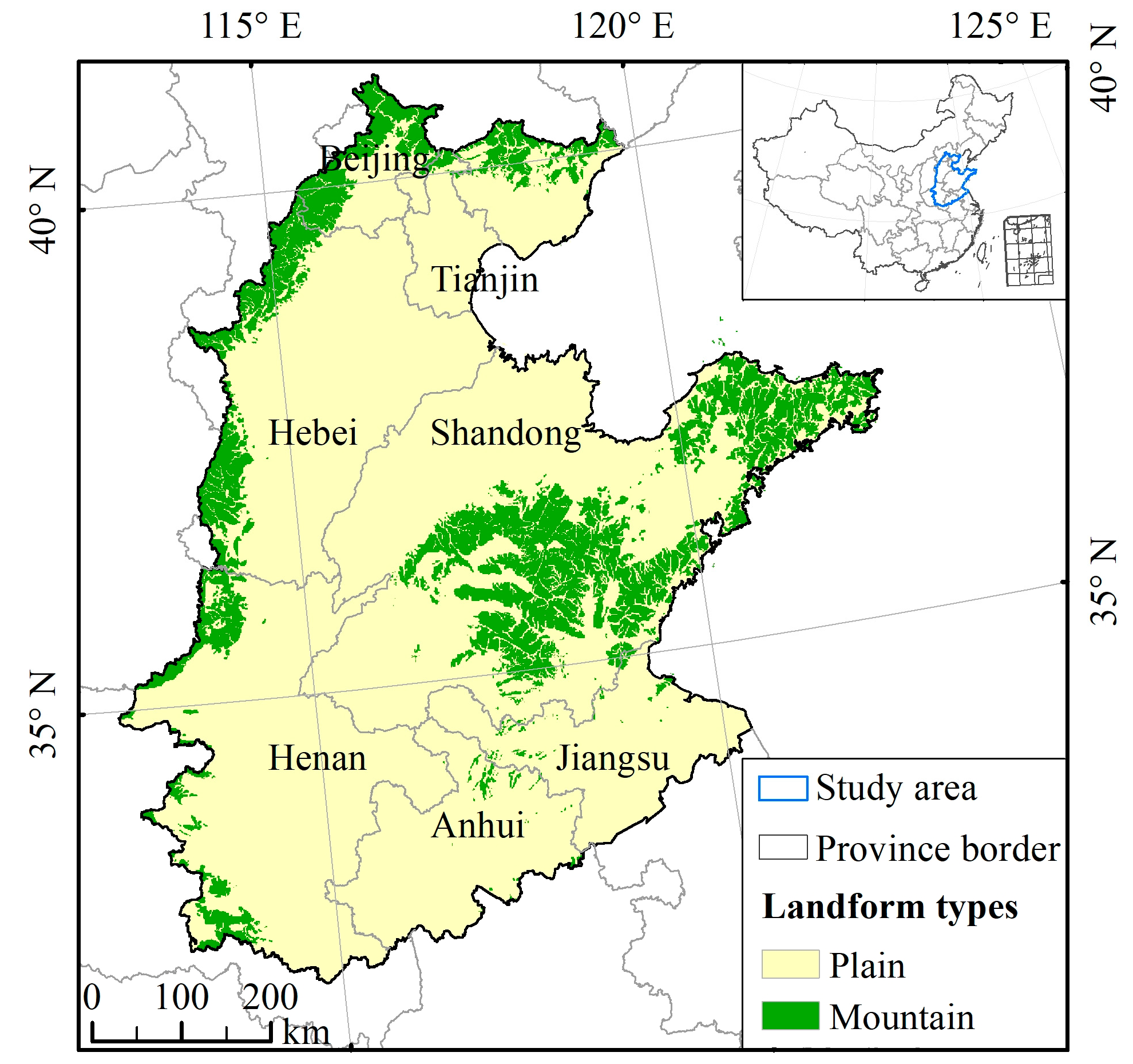
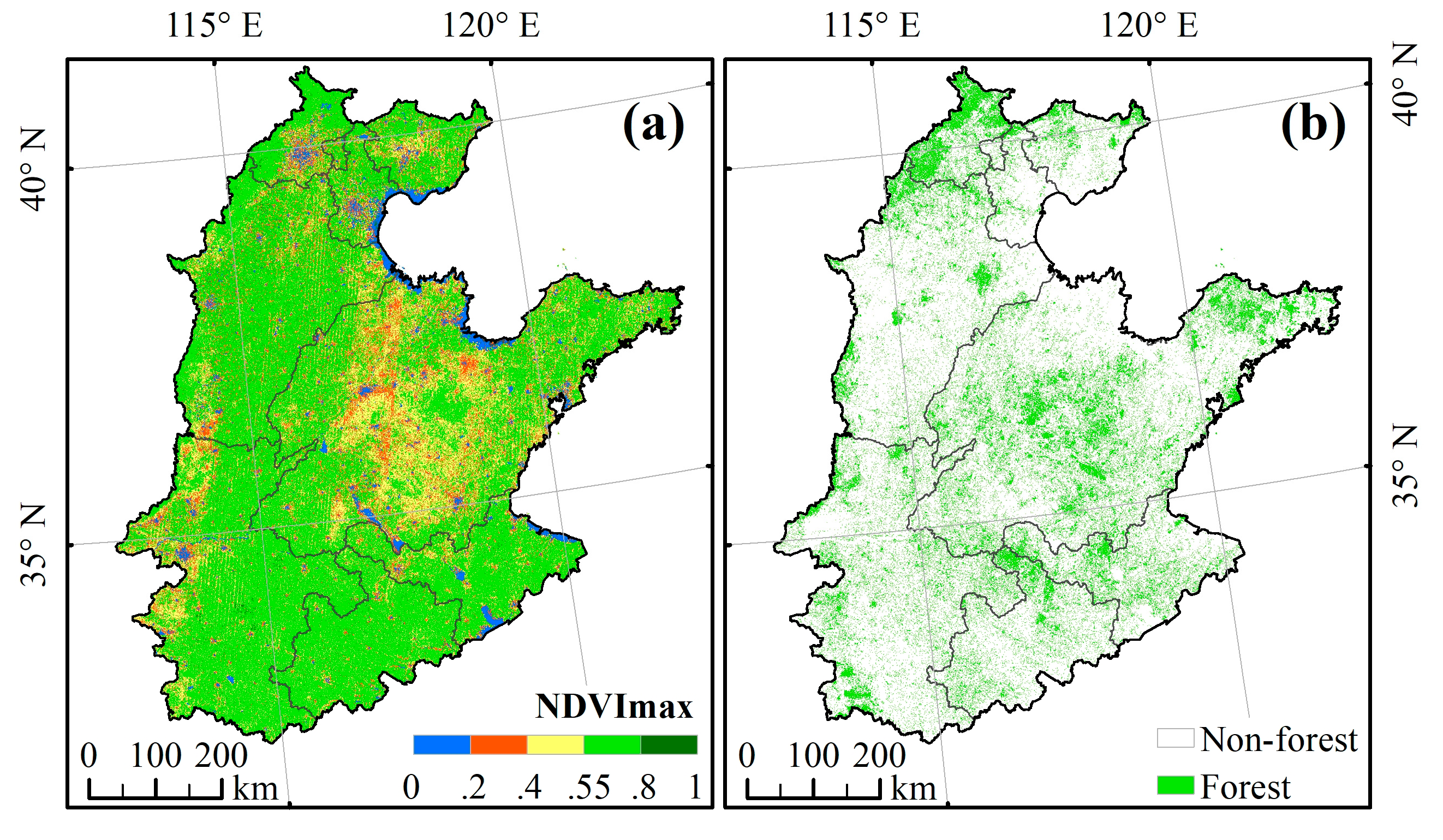
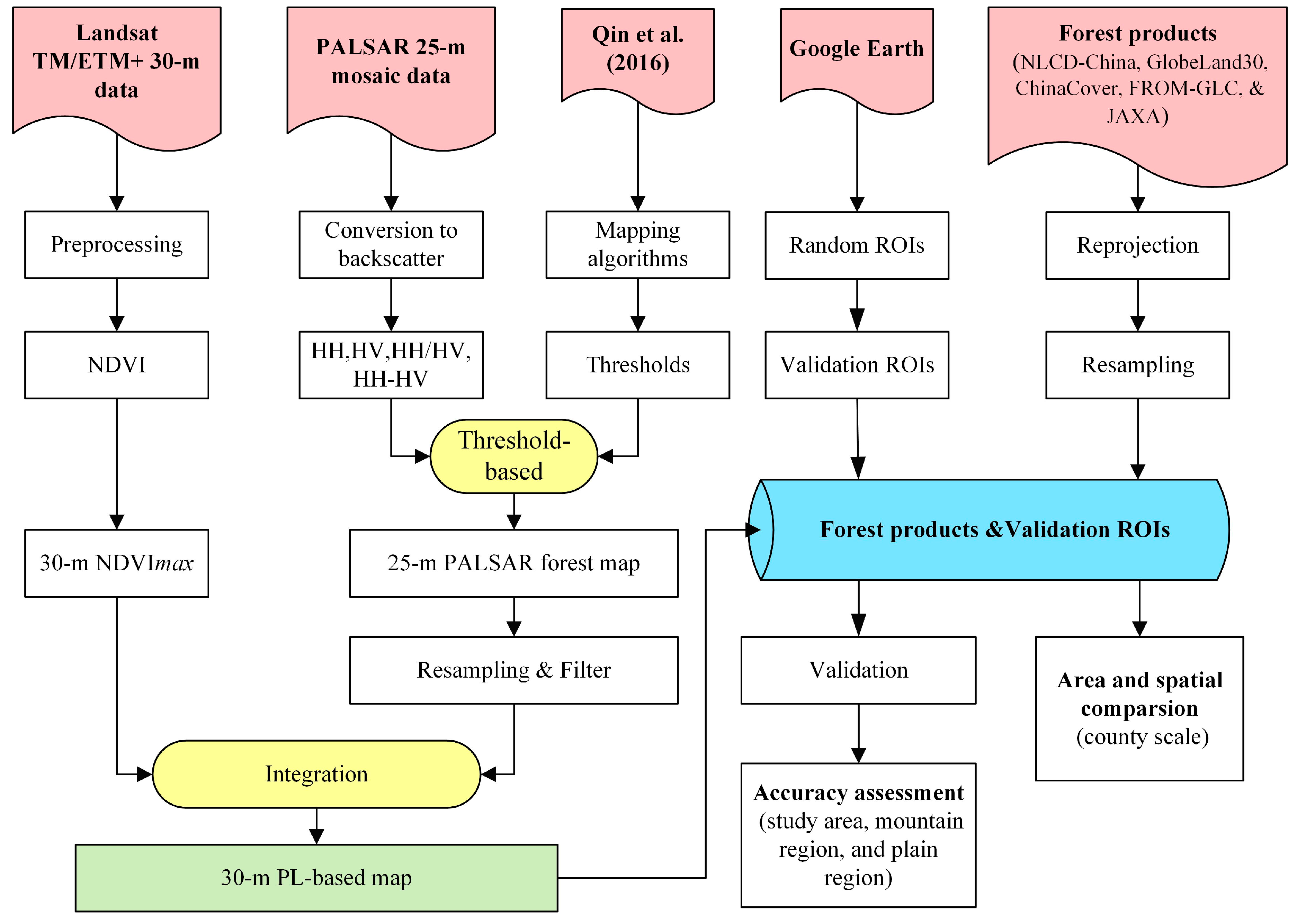
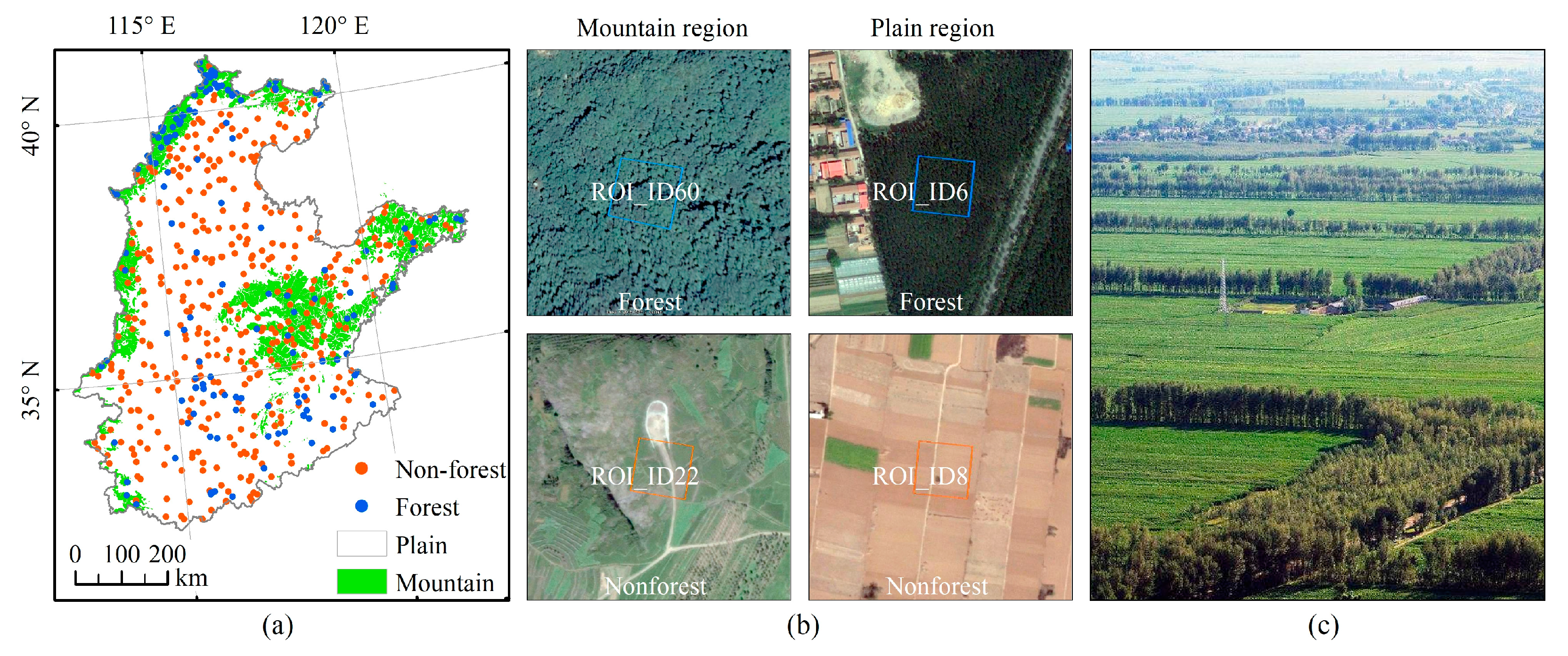
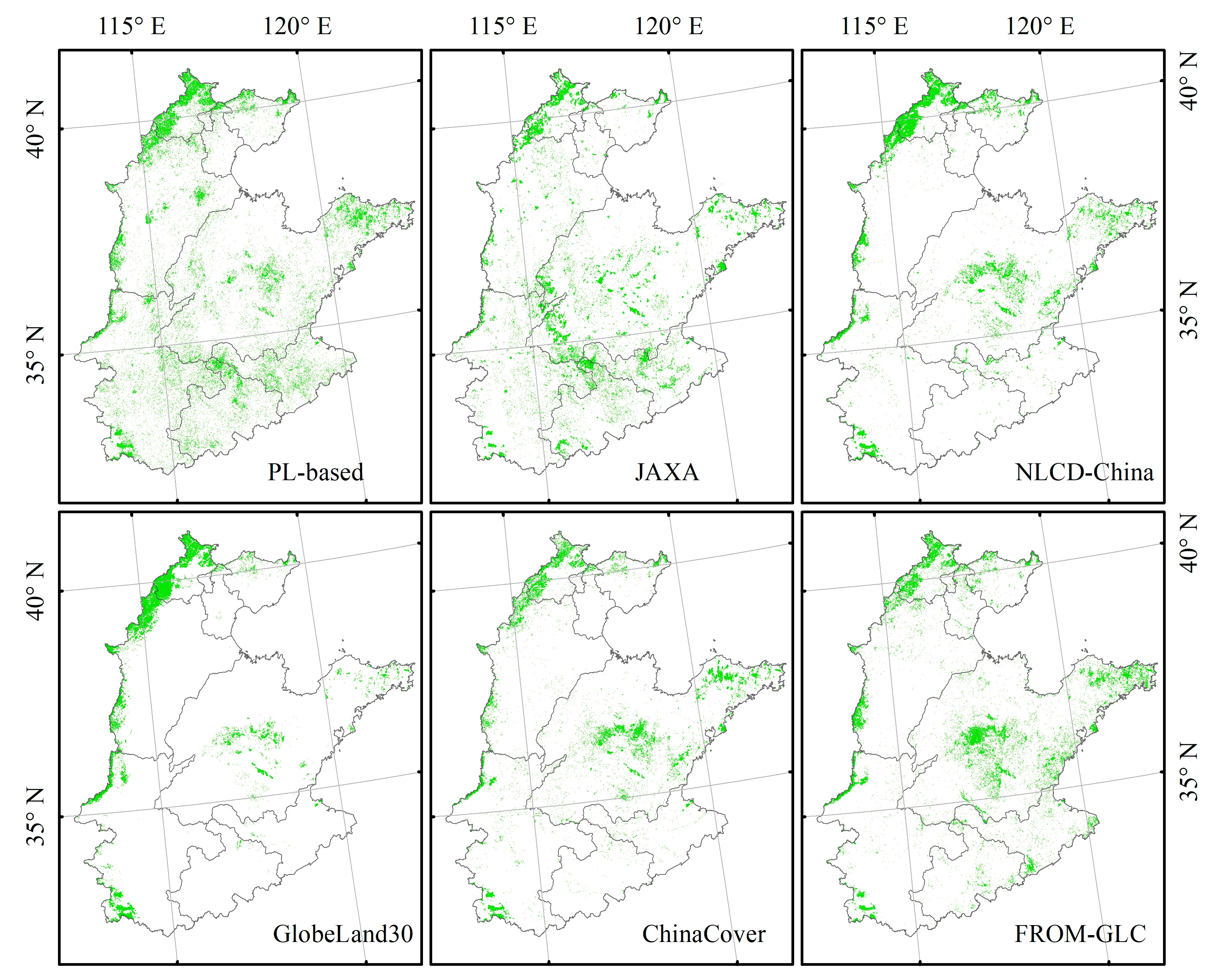
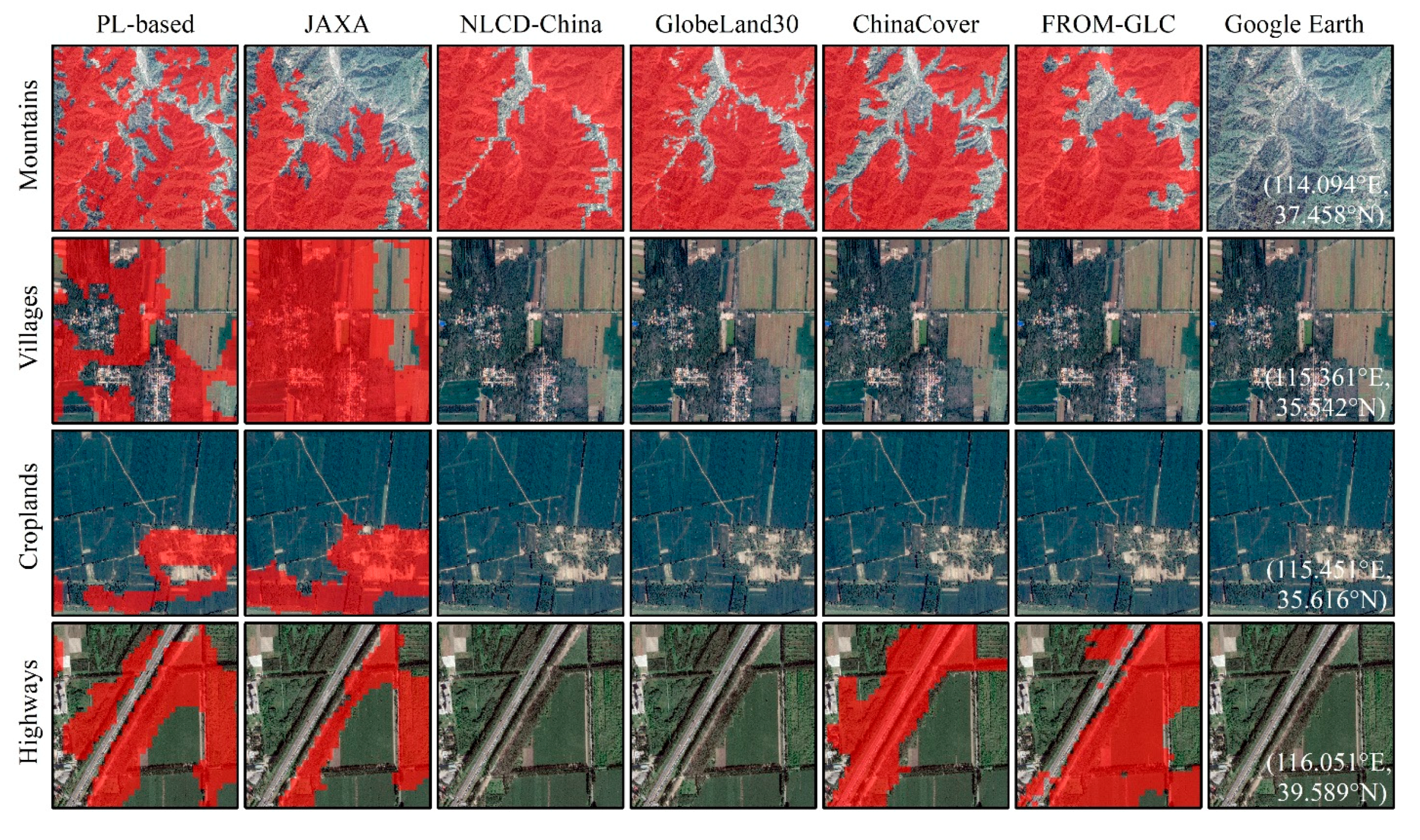

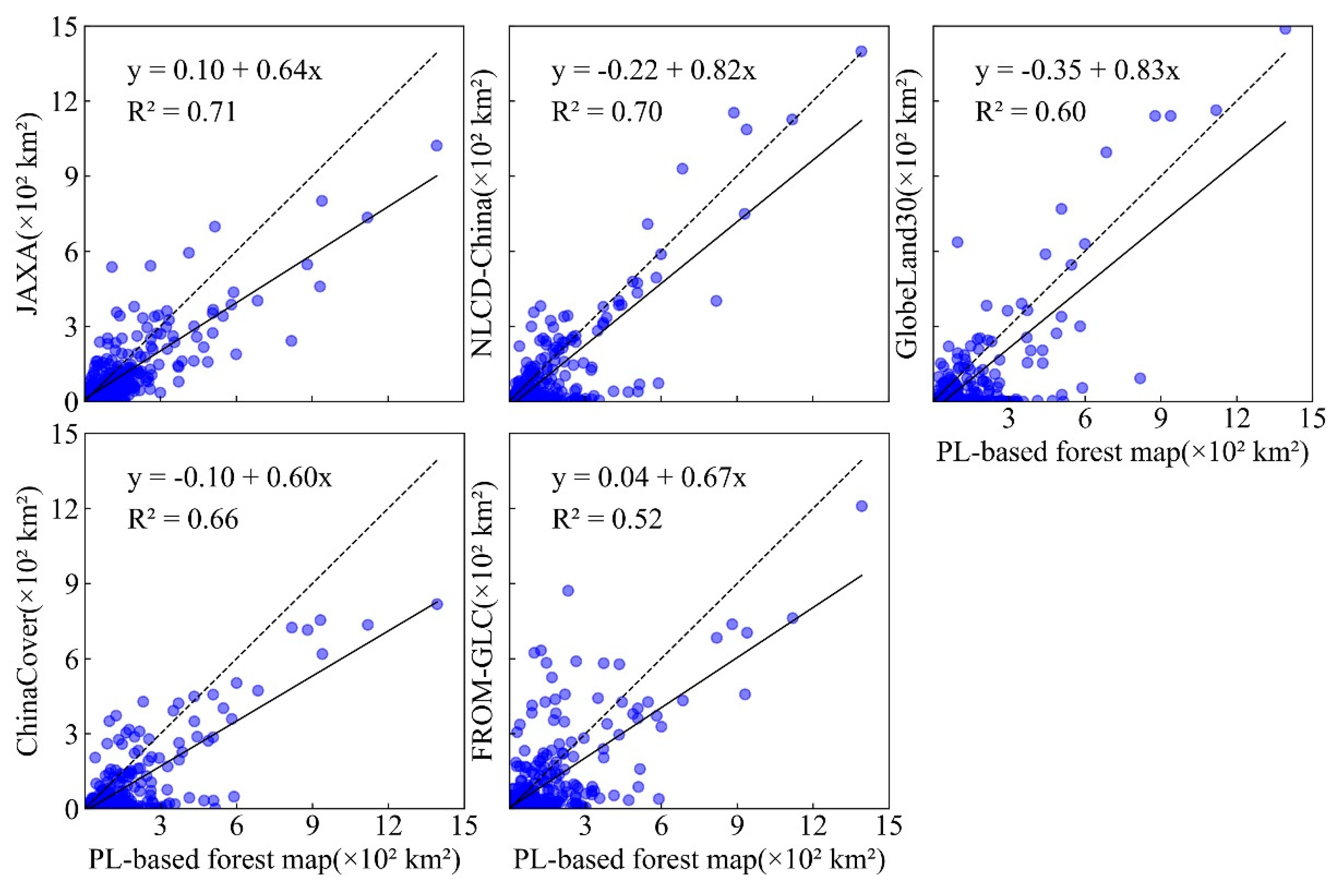


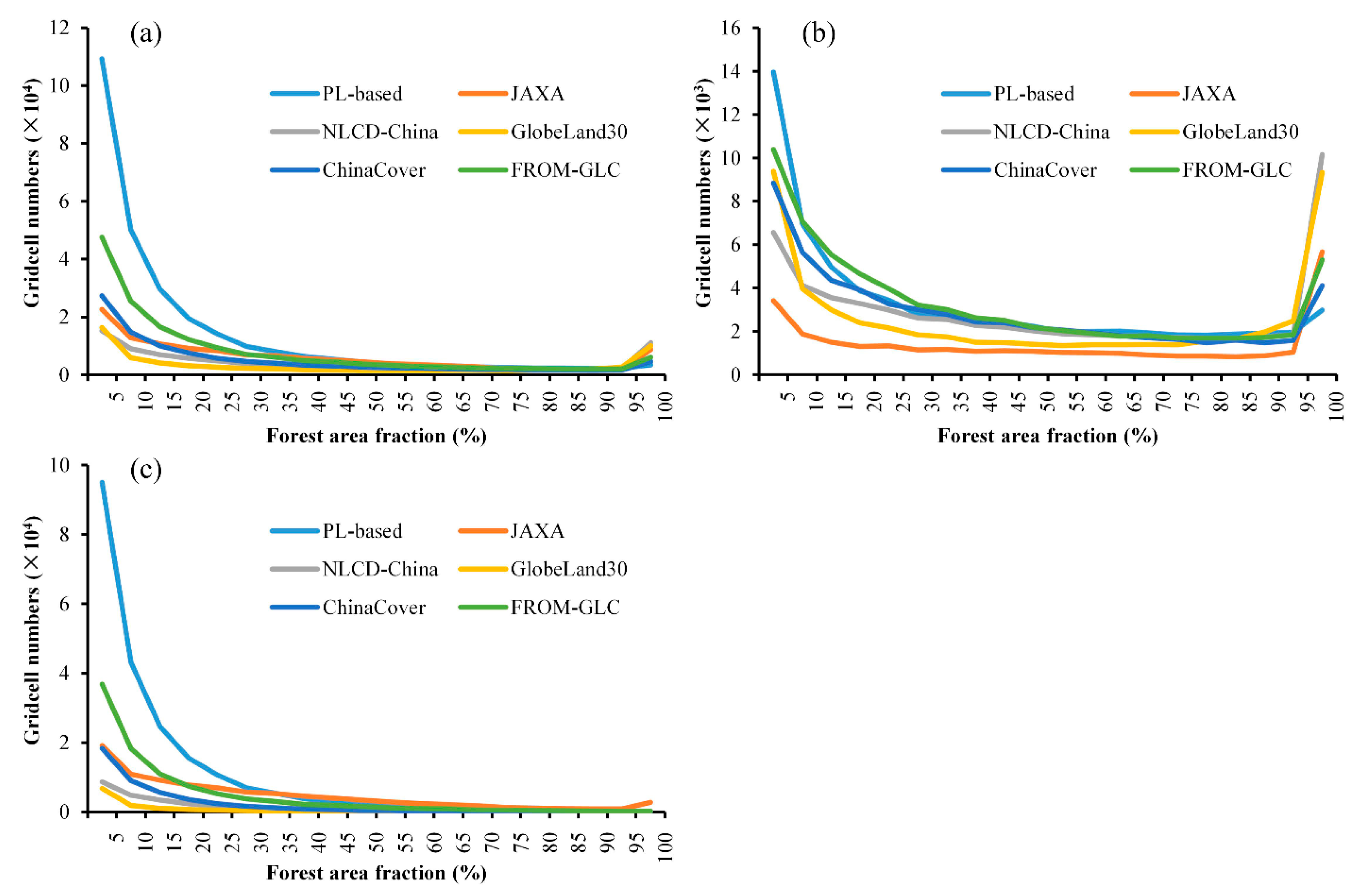
| Forest/Land Cover Products | Forest Definition | Resolution | Data Sources | Algorithms | References |
|---|---|---|---|---|---|
| JAXA | Tree cover ≥ 10%, Tree height ≥ 5m | 30 m | PALSAR | Decision Tree | [2] |
| NLCD-China | Tree cover ≥ 10% | 100 m | Landsat, CBERS and HJ-1A | Visual interpretation approach | [47] |
| GlobeLand30 | Tree cover ≥ 10% | 30 m | Landsat, HJ-1 | POK-based method | [48] |
| ChinaCover | Tree cover ≥ 20%, Tree height ≥ 3m | 30 m | HJ-1A/B, MODIS | Object-oriented classification | [49] |
| FROM-GLC | Tree cover ≥ 15%, Tree height ≥ 3m | 30 m | Landsat | Supervised classification | [50] |
| Forest Maps | Landform | Wi | UA | PA | OA | Kappa |
|---|---|---|---|---|---|---|
| PL-based | Study area | 0.10 | 0.92 ± 0.02 | 0.71 ± 0.05 | 0.95 ± 0.01 | 0.86 |
| Mountain | 0.25 | 0.97 ± 0.02 | 0.68 ± 0.07 | 0.88 ± 0.04 | 0.83 | |
| Plain | 0.07 | 0.84 ± 0.05 | 0.71 ± 0.07 | 0.97 ± 0.01 | 0.82 | |
| JAXA | Study area | 0.08 | 0.85 ± 0.03 | 0.48 ± 0.04 | 0.92 ± 0.01 | 0.76 |
| Mountain | 0.16 | 0.97 ± 0.02 | 0.38 ± 0.04 | 0.74 ± 0.05 | 0.67 | |
| Plain | 0.06 | 0.73 ± 0.06 | 0.59 ± 0.08 | 0.96 ± 0.01 | 0.73 | |
| NLCD-China | Study area | 0.06 | 0.94 ± 0.02 | 0.31 ± 0.03 | 0.87 ± 0.02 | 0.64 |
| Mountain | 0.30 | 0.96 ± 0.02 | 0.70 ± 0.06 | 0.87 ± 0.04 | 0.80 | |
| Plain | 0.01 | 0.75 ± 0.05 | 0.06 ± 0.01 | 0.87 ± 0.02 | 0.15 | |
| GlobeLand30 | Study area | 0.05 | 0.95 ± 0.02 | 0.26 ± 0.02 | 0.86 ± 0.02 | 0.64 |
| Mountain | 0.26 | 0.97 ± 0.02 | 0.70 ± 0.06 | 0.88 ± 0.04 | 0.83 | |
| Plain | 0.01 | 0.64 ± 0.06 | 0.04 ± 0.01 | 0.86 ± 0.02 | 0.10 | |
| ChinaCover | Study area | 0.05 | 0.95 ± 0.02 | 0.26 ± 0.02 | 0.87 ± 0.02 | 0.61 |
| Mountain | 0.24 | 0.99 ± 0.01 | 0.53 ± 0.05 | 0.79 ± 0.04 | 0.72 | |
| Plain | 0.01 | 0.76 ± 0.06 | 0.07 ± 0.01 | 0.87 ± 0.02 | 0.23 | |
| FROM-GLC | Study area | 0.07 | 0.86 ± 0.03 | 0.30 ± 0.02 | 0.85 ± 0.02 | 0.56 |
| Mountain | 0.26 | 0.92 ± 0.03 | 0.51 ± 0.04 | 0.74 ± 0.04 | 0.61 | |
| Plain | 0.03 | 0.57 ± 0.06 | 0.13 ± 0.03 | 0.86 ± 0.02 | 0.19 |
© 2018 by the authors. Licensee MDPI, Basel, Switzerland. This article is an open access article distributed under the terms and conditions of the Creative Commons Attribution (CC BY) license (http://creativecommons.org/licenses/by/4.0/).
Share and Cite
Yang, Z.; Dong, J.; Qin, Y.; Ni, W.; Zhao, G.; Chen, W.; Chen, B.; Kou, W.; Wang, J.; Xiao, X. Integrated Analyses of PALSAR and Landsat Imagery Reveal More Agroforests in a Typical Agricultural Production Region, North China Plain. Remote Sens. 2018, 10, 1323. https://doi.org/10.3390/rs10091323
Yang Z, Dong J, Qin Y, Ni W, Zhao G, Chen W, Chen B, Kou W, Wang J, Xiao X. Integrated Analyses of PALSAR and Landsat Imagery Reveal More Agroforests in a Typical Agricultural Production Region, North China Plain. Remote Sensing. 2018; 10(9):1323. https://doi.org/10.3390/rs10091323
Chicago/Turabian StyleYang, Zhiqi, Jinwei Dong, Yuanwei Qin, Wenjian Ni, Guosong Zhao, Wei Chen, Bangqian Chen, Weili Kou, Jie Wang, and Xiangming Xiao. 2018. "Integrated Analyses of PALSAR and Landsat Imagery Reveal More Agroforests in a Typical Agricultural Production Region, North China Plain" Remote Sensing 10, no. 9: 1323. https://doi.org/10.3390/rs10091323
APA StyleYang, Z., Dong, J., Qin, Y., Ni, W., Zhao, G., Chen, W., Chen, B., Kou, W., Wang, J., & Xiao, X. (2018). Integrated Analyses of PALSAR and Landsat Imagery Reveal More Agroforests in a Typical Agricultural Production Region, North China Plain. Remote Sensing, 10(9), 1323. https://doi.org/10.3390/rs10091323










